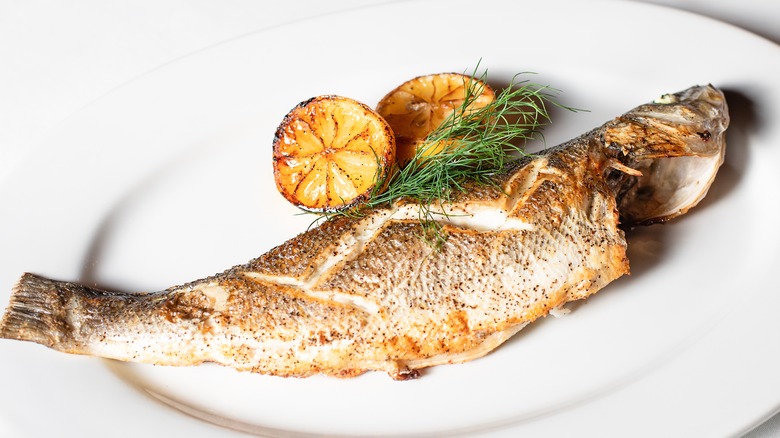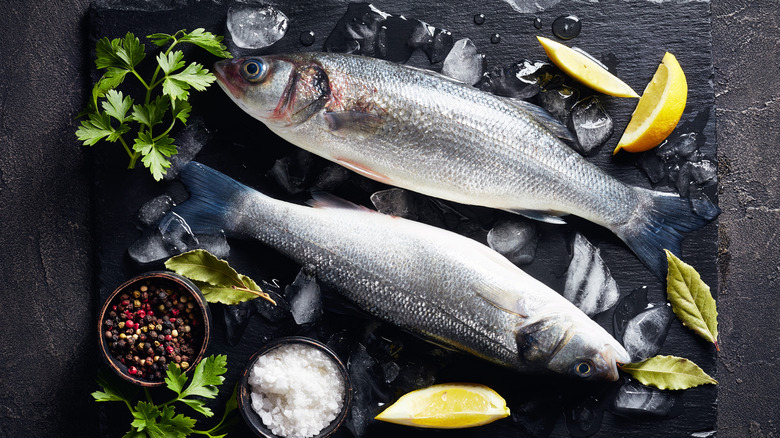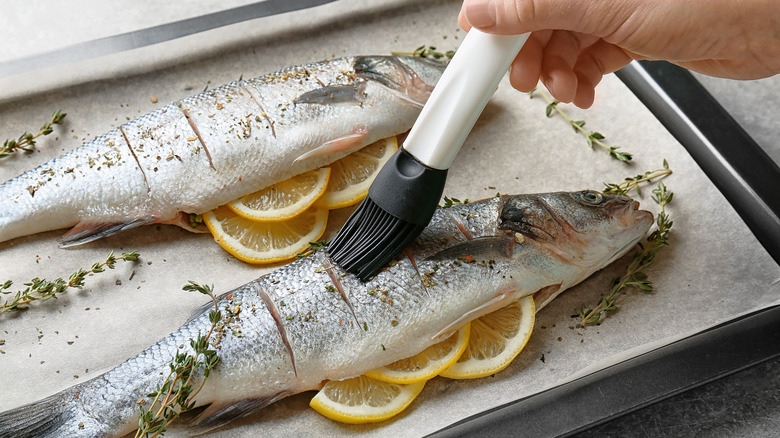Why Branzino Is Almost Always Served Whole
If it's featured on a restaurant menu, a whole branzino is one of the best things you can order. The fish has historically been sourced from the coastal regions of the Mediterranean Sea, making it a popular choice in Italian and Greek cuisines. It's most commonly roasted, but it can also be prepared by grilling, frying, or steaming. No matter how it's prepared, branzino is almost always served whole due to its unique size and anatomy.
The fish weighs in at an average of two pounds. This means that it's large enough to contain plenty of meat, but not so big as to become unmanageable. It also contains fewer bones than many other fish, which makes for a more hassle-free eating experience.
Branzino is also known for its thin skin, which crisps up beautifully when cooked. Because a whole fish is served skin-on, you always want to present a dish with edible, tasty exteriors. You also need to use something with firm enough meat that it will hold its shape during the cooking process. Once again, branzino is a hit in this department since its meat is resilient, with a pleasingly firm texture.
At the end of the day, however, it all comes down to the flavor. Branzino's meat is sweet, pleasantly flaky, and can be used in many cooking applications. Comparable to halibut or sea bass, the fish's mild taste means that it can be paired with a wide variety of aromatics and ingredients.
Selecting the right fish to make branzino at home
Branzino is great to order at a restaurant, but it's also an excellent choice to cook at home. If you've ever wondered what to do with a whole fish, the first step it is to select something fresh. You can gauge how fresh a fish is by looking at its eyes. Clear, wet eyes mean that it was recently harvested, while cloudy or shrunken eyes tell you it's been sitting out too long. You can also tell by the smell of the fish. Any off odors are an immediate red flag.
While you're selecting a fresh branzino, you also want to make sure you're buying a sustainable option. Because of its popularity, branzino has become dangerously overfished. Fortunately, many are now farm-raised not just in the Mediterranean but in the United States as well. When you buy the fish, look for certifications like Global GAP or Friend of the Sea, which testify that it has been responsibly farmed.
Once you've found the right option, ask your fishmonger (whether it's the seafood counter at your supermarket or a local store) to clean, gut, and trim the fish for you. After that, take it home and it will be ready to cook.
How to cook a whole branzino
Cooking a whole fish might seem intimidating, but it can actually be quite simple. Few dishes will appear as fancy while requiring so little work. Start by taking your clean branzino and patting it dry. Removing excess moisture makes it easier for the skin to crisp and brown. Next, cut some small vertical lines into the fish skin. Scoring the skin like this means it will sit more evenly, resulting in uniformly cooked skin. Now all that's left to do is stuff your fish with tasty aromatics like lemon and your favorite herbs, rub it with salt and oil, and cook it in a hot oven set to 325 degrees Fahrenheit.
You can try out many recipes this way, like roasted branzino with fennel. Once you've gotten the hang of roasting a fish, you can move on to other technique as well. Branzino makes a great option for a Greek-style grilled fish with marinated tomatoes. With a little bit of practice, you can turn just about any whole fish into a show-stopping centerpiece for your next dinner party.



